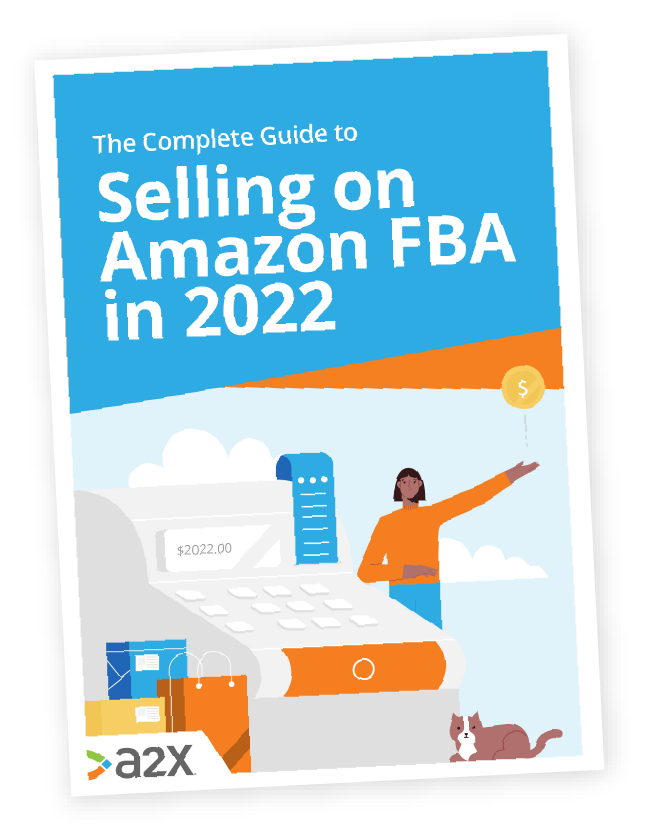![How To Sell To Amazon Directly [Guide]](/img/blog/small-blog-amazon-pay-copy-min.jpeg)
How To Sell To Amazon Directly [Guide]
When most people think about doing business with Amazon, it’s in the format of using the platform to sell to customers. But this isn’t the only option.
You can sell to Amazon directly, as part of their vendor program.
Becoming an Amazon vendor takes away the customer service or brand management aspect of your business, replacing it with a focus on distribution and fulfilment. You are the backend, not the front.
So what’s involved in being an Amazon vendor? Is it open to anyone or reserved for a special few? Is there more money to be made this way?
In this guide on how to sell to Amazon directly:
Table of Contents
The best advice and insights for selling on Amazon this year
There’s a lot to know when it comes to selling on Amazon. In this guide, you’ll find expert tips and advice to make sure you start strong and stand out from the crowd.
Download our free guide
Ready? Let’s do it.
What is an Amazon Vendor?
An Amazon seller trades with customers. An Amazon vendor trades with Amazon.
When you become an Amazon vendor, the products you supply are listed, priced and marketed to customers by the platform, endorsing the items with “in-stock, shipped and sold by Amazon.”
There used to be two routes to becoming an Amazon vendor.
You could either wait to be invited to the vendor program by Amazon, or start small with Vendor Express which was open to anyone. Unfortunately, the latter was folded a couple of years back due to a few issues including:
- Long payment cycles and slow “test” orders - some vendors experienced a delay of up to 120 days for payment from the platform.
- Vendors had no control over pricing or inventory, which were set by Amazon’s algorithm and not negotiable.
Today, those who want to be vendors must start at the beginning with all Amazon sellers: Trading directly with customers via Seller Central.
What fees are involved?
There are still fees for Amazon vendors but they look a little different.
There is a premium vendor service available for a yearly charge, but otherwise, vendors pay for the use of Amazon’s services like AMS, stock management and any internal support required rather than individual fees per product.
Vendors may also need to take shipping costs into account to get stock to the fulfilment centers, and potentially any taxes and import duties for overseas mail.
For Amazon sellers, fees are set - there’s no negotiation. This may not be the case for vendors, so there’s room for movement which might pique your interest or put you off entirely. Either way, be prepared.
Amazon Vendors: Pros & Cons
What are the advantages of selling directly to Amazon as a vendor, and the disadvantages? Let’s take a look.
Amazon vendor advantages
- Higher sales potential.
- More trust reassurance for buyers with the “sold by Amazon” label.
- Amazon retail often wins the buy box, so you might have a greater chance of this too.
- Access to FBA and Amazon’s super fast fulfilment services.
- Arguably simpler fee structure compared with sellers.
- Customer support and returns are covered by Amazon.
- Access to exclusive services like Amazon Vine (a customer review program).
Amazon vendor disadvantages
- You may need to send Amazon “test” items first which essentially means free trials (at your expense). Amazon will sell a few of these before making any decisions about whether to partner with you.
- You have no control over pricing.
- Amazon can negotiate its purchasing price and holds much of the power.
- It’s an invite-only program, reserved for high-performing, promising sellers.
- Vendor Central may not supply analytics that are as detailed as in Seller Central.
- Payment cycles may be slow - this was a criticism of the Vendor Express program so check the Ts & Cs when you sign up if this will negatively impact your cash flow.
- If your items are slow to sell, you may be charged additional fees.
That’s a pretty decent list of disadvantages. Whether to go vendor or not really depends on your preference of business model. Do you want to be a first or third-party seller? How much do you want to get rid of customer service from your task list?
Essentially you will swap dealing with customers for dealing with Amazon, and one of those gives you significantly less control over your business than the other.
To help you decide, we’ll next look at the experience of the Amazon vendor vs. seller in greater depth.
Amazon Vendors vs. Amazon Sellers
Anyone wanting to do business with Amazon has to start as a seller, there’s no getting around that and it’s been the case from day one.
In order to become a vendor (or use Vendor Express back when that was an option), you need a decent seller rating first.
So if you’re already selling on Amazon and keen to bait that vendor invite, you’ll know a bit about the pros and cons of the platform already. If you’re not yet signed up, you will need to find your feet selling to customers first.
The below pros and cons are specifically in relation to the vendor experience so you can compare the two directly.
Amazon seller advantages (over vendors)
- It’s open to (mostly) anyone, no invites necessary.
- You have flexible fulfilment options via FBA (Fulfilment by Amazon) or FBM (Fulfilment by Merchant).
- You have more control. Amazon still has rigorous expectations about pricing and your listings but ultimately, these are up to you.
- You deal with your customers. You can manage satisfaction, control messaging and ensure quality.
- Seller Central has a greater range of features for more customization of your business than Vendor Central, with arguably better analytics.
Amazon seller disadvantages (over vendors)
- You do all the heavy lifting with your listings and customer service.
- You manage fulfilment yourself (even with FBA you’ll need some level of involvement).
- There’s no “sold by Amazon” sticker on your listings.
- It may be more difficult to win the buy box for maximum visibility.
- Any advertising and marketing you do will all be on you.
- You don’t have access to exclusive services like Amazon Vine (unless invited as a top-rated, top-performing seller by the platform).
Fees are one thing we’ve left out because whether they’re a pro or con depends on your preferences.
Amazon seller fees are notoriously numerous and hard to interpret, (so much so that we have a number of guides to explain their various forms and features).
If you would rather have a set fee structure, even if it’s complex and at times confusing, then the seller route might be best for you. If you are open to negotiable fees and costs which could change over time, then you’ll probably have no issues transitioning to a vendor.
Either way, fees are going to be a part of your business life with Amazon - but A2X has your back, and we’ll get to that later.
Tips for Being a Successful Amazon Vendor
The recipe for success for Amazon vendors is not unlike that for sellers. It comes down to a few core components that, when managed well, are sure to give you the best chance for success.
Since it starts with being a great Amazon seller either way, focus on this first. It will not only prompt that all-important vendor invite, but prep you for the next level of Amazon selling - direct to the platform.
In our blog The Amazon FBA Secret Recipe to Success, we list these steps as a basis for your seller journey:
- Create an account and get yourself verified.
- Choose the right products to sell - do your research.
- Pick your fulfilment method carefully and price it up beforehand - can you make a profit?
- Find quality suppliers and meet with them if you can - build a relationship.
- Treat your customers well and constantly look for room to improve.
Once you are selling regularly and bringing in those great reviews, you’re ready for the next level.
In our blog 5 Growth Opportunities for Amazon FBA Sellers, we discuss ways to expand via the following areas:
- Planning for seasonality.
- Marketing efficiently and effectively.
- Building on supplier relations.
- Streamlining your accounting.
- Optimizing your cash flow management.
Whether you’re a seller or a vendor, your business needs money to function. Without proper management and visibility over your finances, you can’t be successful at either.
The fees, income and expenses associated with any ecommerce business no matter the model or platform need to be kept in check. Without knowing the past, present and future of your cash flow, planning for seasonal changes, long payment cycles and fee increases will be almost impossible.
Enter: A2X.
A2X for Automatic, Accurate Amazon Books
Your Amazon bank deposits, whether you’re a seller or a vendor, will comprise multiple line items not separated for you.
How will you catch fee increases, mistakes or sales tax amounts? Well, you won’t, not without hours of manual calculations. But there is another way.
A2X is a connector app that integrates with Amazon and your accounting software to act as a mediator. It downloads the transactional information from Amazon, splits out the income and expense lines associated with each bank deposit and shows you exactly what they represent in neat journal summaries.
It also takes Amazon statements and splits them by month, organizing your books via the accrual method so that you can analyze your performance not just by how much cash you have, but by what’s coming up too. This allows you to plan ahead when managing cash flow and ensure your business always has enough resources.
Try A2X for Amazon today on a free trial.
Also on the blog
The best advice and insights for selling on Amazon this year
There’s a lot to know when it comes to selling on Amazon. In this guide, you’ll find expert tips and advice to make sure you start strong and stand out from the crowd.
Download our free guide

